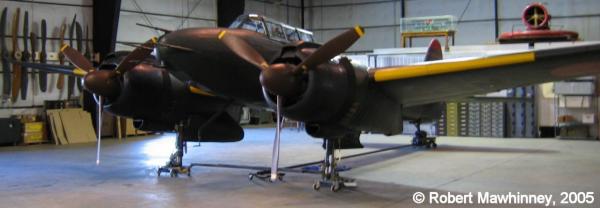
NASM Japanese Engine Research, Page 1
|
Japanese engine researcher Robert Mawhinney, of the Smithsonian National Air and Space Museum, has kindly provided a collection of "working" images he uses in his research. Regarding the images, Rob says, "These are not all the greatest photos. They are used to avoid climbing the racks at Garber, pencil/paper in hand, to translate data plates and take notes on details. They also help save time by not moving engines here and there. They are a good peek into the Japanese engine collection at NASM though, for that alone they are worth it." We could not agree more! |
Japanese Aircraft Engines - The Book (research in progress)
Nakajima J1N1-S Gekko
One of my current projects fits into the Japanese engine work nicely. I'm part of a three-man crew disassembling NASM's Nakajima J1N1-S Gekko (Code name: "Irving"). The Gekko was restored at NASM some years ago but has never been on public display.
Some time this summer we will move and reassemble it at the Udar-Hazy center. This is a good chance to have a look at the complete installation of a power plant.
The engines are Nakajima Sakae Model 21's. It is interesting to note the differences between the two engines. The right engine's nose case has "Sakae" cast into it in Katakana. Katakana is a phonetic way of “spelling out" Japanese words. The left engine has a “data tag" that uses the Kanji symbol for Sakae and states the model number. The quality of the casting on the right engine nose case is not as good as that of the left engine. Other differences are; No carb data plate on the right engine, rocker box oil sumps are not the same and many other minor details.
The carburetors are Nakajima two-venturi Model 100 "Ko" units on both engines. Of note in the close up of the carb from the rear are the two large hoses running to it. These are engine oil lines feeding hot oil through the carb for anti-icing protection.
Right Engine (Nakajima)
 |
 |
 |
 |
 |
 |
| Sakae Model 21 | Sakae Model 21 | Sakae Model 21 | Sakae Model 21 | Sakae Model 21 | Sakae Model 21 |
Left Engine (Nakajima)
 |
 |
 |
 |
 |
 |
 |
| Sakae Model 21 | Sakae Model 21 | Sakae Model 21 | Sakae Model 21 | Sakae Model 21 | Sakae Model 21 | Sakae Model 21 |
Sakae Model 21 Specifications
Bore = 130 mm
Stroke = 150 mm
Displacement = 27.9 liters
Compression Ratio = 7.0:1
Power:
Takeoff = 1,130 hp @ 2,750rpm
Low Blower = 1,070 hp @ 2,700rpm @ 2,850 meters
High blower = 940 hp @ 2,700 rpm @ 6,000 meters
Propeller Reduction Gear Ratio = 0.5833, planetary spur
More Japanese Engines
Nakajima Homare 21
Hitachi "Hatsukaze Model 11"
Another Hatsukaze -- but with a twist
Tsu 11 on Ohka 22
Hitachi Amakaze 31 (Also known as Tempu 31)
Tentative Identification: Army Type 98 450Hp Radial (Army Ha13 "Ko")
Ha 31-21 Zuisei 21, Army Type 1 1050 hp Radial, Army Ha 102)
Ha32-21 Mitsubishi Kasei Model 21 (MK4P)
Ha32-22 Mitsubishi Kasei Model 22 (MK4Q)
Army Type 1 1,050 hp Radial Army Ha102, Mitsubishi Zuisei 21)